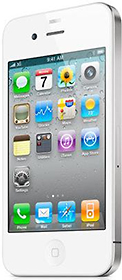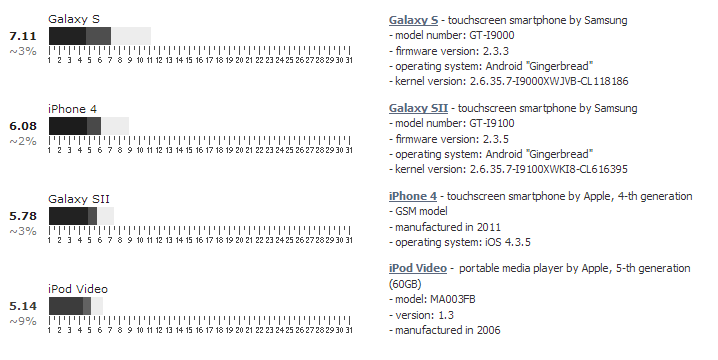Published Date 8/8/11 10:14 AM
Update 2015 Aug 26
Although iPhone 4 and iPhone 4S will hardly be added to SE listening tests again, results of their objective measurements are worth publishing.

Figure 1. Results of testing media player of iPhone 4 with various audio signals and single measurement approach based on Difference level parameter.

Figure 2. Results of testing media player of iPhone 4S with various audio signals and single measurement approach based on Difference level parameter.
Looking at these readings we can safely conclude that the whole line of iPhone products – at least starting from iPhone 4 and up to iPhone 6 – has exactly the same quality of its audio circuits. In other words those who use iPhones as an audio player will not hear any difference between the models.
Starting from July 2015 testing scheme for digital audio players was modified. Instead of Koss Porta Pro headphones the plain resistive load of 33 Ohm is used now. Also accuracy of the test file processing for analog circuits was improved substantially. Unfortunately resulting new ratings of DAPs are not compatible with the old ones, so the latter were removed. Sorry.
New info, if any, about iPhone 4/4S will be posted above this disclaimer. Previous article with the results of iPhone 4 listening test is under this disclaimer for archival purposes.
 |
iPhone 4/4S
smartphone by Apple |
It finally happened, new section "Portable Players" has its first contender – iPhone 4 (white GSM model with iOS 4.3.5 and 8Gb of storage). This “player” was chosen due to a few reasons:
- it is popular
- it has the same audio circuitry as iPod Touch 4 and therefore produces very similar level of audio quality
- convergence of portable players and means of communication seems to be inevitable
This is a beginning, all other players will be chosen according to your suggestions as usual. Procedure of recording SE test signal for portable players is pretty solid now, so we are not excluding possibility to ask help from people outside SE to record SE test signal for some players which we don't have at our disposal, especially as we already had successful experience of this kind with MD-recorders (ATRAC) a year ago.
Here is some basic points of testing conditions for portable players at SE:
- nine SE sound samples are uploaded to player as uncompressed WAV file
- all audio enhancements are off
- headphone's out of player is loaded with headphones Koss Porta Pro
- playback level is adjusted to have some predefined and equal for all players sound pressure level
- output signal (with headphones load) is recorded by hi-res recorder (MicroTrack II at the moment)
- after precise time warping of recorded signal it is treated like any other output signal at SE – sound artifacts amplification, preparing of test files, usual SE listening tests …
(full specs of testing conditions will be available in “Portable players” section)
With these testing conditions we tried to achieve two goals:
- to make sound quality testing as close as possible to real-life usage of portable players
- to make resulting ratings directly comparable to existing SE ratings (of audio codecs)
Testing details specific to iPhone 4
Along with usual nine SE samples we also used sinusoidal signal (1kHz, -12dB RMS) and white noise (Gaussian, -12dB RMS) for some technical measurements. In particular the most interesting are the levels of degradation of initial shapes of those signals. Being transferred through player the signals are distorted to some level which can be conveniently measured with Difference level parameter. Lower Df values correspond to more accurate (less distorted) transfer of signals. The utmost limits of Df parameter are:
-∞ [db] – signal shapes are perfectly identical
0 [dB] – signals are completely different (nothing in common at all)
Table 1. Difference levels [db] of various signals transferred through iPhone 4.
Sine@1kHz
88dB SPL | White noise
88dB SPL | J.S.Bach
82dB SPL | Bass
83dB SPL | Castanets
80dB SPL | French male speech
84dB SPL | Glockenspiel
77dB SPL | Harpsichord
79dB SPL | Postscriptum
80dB SPL | Mike Oldfield
83dB SPL | Quartet
85dB SPL |
| -74.05 (L) | -4.58 (L) | -32.60 | -32.21 | -19.59 | -31.76 | -27.94 | -16.71 | -23.41 | -17.69 | -35.71 |
| -73.94 (R) | -4.58 (R) |
According to the measurements sinusoidal signal is transferred rather accurately (Df ~ -74 dB). For sinusoidal signals and small Df values Difference level can be easily converted to THD+Noise:
THD+Noise (dB) ≈ Df [dB] + 3 [dB].
Resulting value of THD+Noise -69 dB (0.04%) looks good for a portable player loaded with headphones. But if we replace sine with white noise Df drops to -5 dB. In this case we can't convert Df to THD as the latter is defined for pure tones only. Keeping that in mind we can still formally convert Df = -5.6 dB to THD+Noise = -0.9 dB (90%) and say that white noise being transferred through the player changes its initial shape dramatically. All other real-world sound signals are transferred with Df values between -74 dB and -5 dB (SE nine samples are in the table). Such accuracy spread of reproducing pure tones and more complicated signals is not surprising. This is more or less common for all audio equipment and iPhone 4 actually looks pretty good in comparison with other players that we tested.
Specific feature of iPhone 4 sound is less accurate reproduction of highs in comparison with other frequency regions. This is mostly caused by phase distortions. SE testing procedure doesn't allow to discern origin of the distortions - hardware circuitry or software processing but it allows to hear them:
Download this Audio in lossless format FLAC:1.09MB
Audio 1. Phase distortions of highs in iPhone 4 amplified. The first sample is reference piano excerpt, the second - output of iPhone 4 with artifacts amplified to +32dB. Outstanding highs reveal phase inaccuracy in that frequency region.
Such inaccuracy could lead to less transparent reproduction of highs, in particular - to blurring of their spatial positions. Resulting effect will depend on how far such inaccuracy is beyond threshold of human perception. No measurements (including artifacts gain) can reveal that, results of SE listening tests are more reliable in this sense as they take into account how any particular bunch of distortions is assessed by human hearing system.
UPDATE: iPhone 4S has the same audio quality as iPhone 4
Despite the fact that audio chip in iPhone 4S has different labeling:
- iPhone 4: Apple 338S0589 / Cirrus Logic CLI1495B0 42L61
- iPhone 4S: Apple 338S0987 / Cirrus Logic CLI1560B0 42L63
the overall audio performance is almost similar to iPhone 4. Results of Df measurements are in the Table 2
Table 2. Difference levels (dB) for signals and samples transferred through iPhone 4S.
The values show how much output waveforms differ from input ones (-∞dB: perfectly similar, 0dB: totally different).
Sine@1kHz
86dB SPL | White noise
86dB SPL | J.S.Bach
80dB SPL | Bass
81dB SPL | Castanets
78dB SPL | French male speech
82dB SPL | Glockenspiel
76dB SPL | Harpsichord
77dB SPL | Postscriptum
78dB SPL | Mike Oldfield
81dB SPL | Quartet
83dB SPL |
| -70.08 (L) | -4.64 (L) | -31.57 | -31.22 | -19.39 | -31.27 | -27.69 | -16.48 | -22.72 | -16.51 | -34.93 |
| -70.05 (R) | -4.64 (R) |
The values are very close to the ones from Table 1. What is more important – audible distortions revealed by sound artifacts amplification are identical. It could be safely concluded that both devices sound exactly the same. The only difference is loudness limit in iPhone 4S, which prevented achieving usual SPL levels while measuring Df levels of SE samples.
For our testing we used white iPhone 4S 32Gb (MD245KH) with iOS 5.1 (9B179). SoundExpert thanks Ivan for the device.
We encourage You to take part in SoundExpert listening tests. All SE ratings, as well as iPhone 4 one, exist only thanks to visitors like you. Testing is short and easy,
visit our listening room for simple 1-2-3 instruction. Thank you in advance!
Please, remember, downloading a test file from SoundExpert you will not necessarily get a test file of iPhone 4. SE testing is blind testing – you don't know the device you test. This is the only reliable way of getting true audio quality ratings, free from any cheating and various human senses other than perception of sound quality. After you have sent your grade you will see the device you tested.
Best regards,
SE Team.
Update. 2015 August 22
Deprecated results of previous listening test of Portable Players. For archival purposes only.
